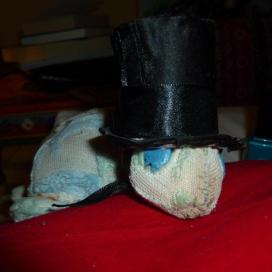Since my friends and I are going on a hike in the French Ardennes this summer, I thought it wise to study a little French. After all, we all know what happens to school-French after you’ve been graduated for awhile. I read Around the World in Eighty Days in Dutch before, so I hoped I would be able to understand the story even when I didn’t know every word. I’m halfway through now and realise I’m not going to finish it before vacation and, also, that my French is terrible.
The story sets off with stoic gentleman Phileas Fogg going about his peaceful business. He is a rich London bachelor, whose daily routine is pegged down to the second. At the start of the book, on 1 October 1872, Fogg takes on a French manservant called Jean Passepartout. This young man hopes for a structured, calm life with the Englishman, after a chaotic past in France. Unfortunately, on Passepartout’s first day of employment, Fogg makes a bet with fellow members of his beloved Reform Club. He thinks that, with advancements in railwaytracks developing as they do, he can travel around the world in only eighty days and he intends to prove this. Departure: that same night.
Unbeknownst to them or the gentlemen who are striking bets on their endeavour, Fogg and Passepartout are followed almost immediately by a very determined detective of the Scotland Yard named Fix. A London bank was robbed by a thief looking like a gentleman and detective Fix’s infallible instinct tells him the culprit is Phileas Fogg, fleeing under the ruse of a ridiculous bet. The poor detective’s dogged determination is kept in check by bureaucracy: a warrant to arrest Fogg follows him around the world, always merely hours too late to be of use.
Meanwhile, Fogg calmly takes delays, obstacles and unexpected cries for help in his stride, while the passionate Passepartout despairs at every setback. Jules Verne created in Fogg the ultimate English gentleman as he saw (and admired) them: rational, generous, taciturn and bloody unstoppable. The thing is, not every obstacle can be removed by a bribe or a convenient elephant (her name is Kiouni). It remains to be seen if the group, joined by a young lady called Mrs. Aouda in India, can make it through three continents in time and without being apprehended by Fix. On their way, they make stupid mistakes like getting drugged in an opium den and pull far-fetched moves to ensure the success of their journey, like instigating mutiny.
Verne’s admiration for the English culture returns in the way he characterises the British Empire: the Europeans somehow bring order and civilisation wherever they go, while chaos and barbaric customs rule supreme in the places they have not yet reached. Descriptions of people or places rarely move beyond the superficial or the stereotypical either. This goes for faraway America and the Asian countries as much as for the main characters: English Phileas Fogg is ever unruffled, French Passepartout is always in a passion. Mrs. Aouda hardly has any dialogue or characteristics apart from being ladylike. These characters, almost caricatures, don’t seem to be the result of imcompetence on Verne’s part though. He uses enlarged versions of reality to poke fun at the slightly ridiculous sides of different cultures. It makes the characters hilarious, if not very realistic.
Verne excels at incredibly detailed description of the route, which runs through Europe, the then-very-new Suez Canal, a great part of Asia, and North America. It gets a little boring here and there but does add to a sense of travelling for the reader. Verne’s clear fascination for modern inventions shines through in the way he writes about different trains and steamers, but his account also contains a lot of good, oldfashioned adventure and intrigue. Perhaps even a love story? It must be a very worthy woman who can pierce the armoured heart of Phileas Fogg while he is busy proving a point.
Back to the superficial. My copy of this classic is not as pretty as many I’ve seen – it’s a battered paperback that my mother picked up in France or Morocco (so it’s not even actually mine). It has the original illustrations, though, which are gorgeous:



The history of Around the World is quite as interesting as the book itself. The story was initially published as a series in France, with its timeline the same as real time (October – December 1872). Some people didn’t realise it was fiction and placed actual bets with actual money on Fogg’s success or failure. How powerful Verne must have felt…
In the many years since its publication, the book has been adapted to film, television and on stage multiple times. Of those adaptations, the 1956 film Around the World in Eighty Days is very well known. It has the famous scene of the hot air balloon in it, which is not actually in the book. The idea is only suggested in the original story as a joke: an adventurous but unrealistic means of long distance travel.
Anyways, people all around the world were fascinated by the idea of travelling around the world. In 1889, excellent American journalist Nellie Bly decided to test Fogg’s theory by following in his footsteps. And guess what? It took her only 72 days AND she met Jules Verne while passing through France. She travelled alone, with very little cash, at twenty-five years old. It makes me wonder what I’m doing with my life. At least I have books; and luckily for most of us, this one is translated to many, many languages.
Top Hat Award for yet another crush on a fictional gentleman
Jules Verne, Le tour du monde en quatre-vingt jours (France, 1873)
Illustrations by Alphonse-Marie-Adolphe de Neuville and Léon Benett

Jo Robin

